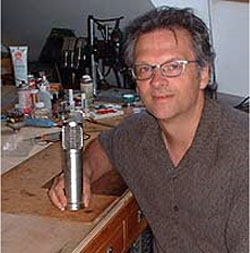
BB: After you modify microphones, do they stay fairly stable, or do they need tune-ups as well?
KH: I’m surprised, some of the stuff I see. Usually after eight or nine years, they come back, with crud on the diaphragm, moisture, the usual stuff. For example, I just got a call from Lucasfilm. They sent in one of their Foley microphones. Somebody had knocked if off the stand and it started sounding funny. And if I haven’t seen a microphone in over five years, I automatically upgrade my previous modifications, because I have learned so much in the last five years.
But in the end, and I cannot stress this enough, if you cannot hear what you are after, it doesn’t matter what you measure. I have found only a couple items…for example, our Brauner microphone, the most expensive new microphone you can buy, $8500, to this day not a single soul has asked for the technical specifications of this microphone. Either it’s there or it’s not. It is so beyond these primitive parameters of most technical specifications.
The only technical specification I emphasize is noise floor. That’s where I’m sensitive. I’ve found that even good cabling can suppress the hash of RF a little bit better, so the resolution blooms a little bit more. Even if you cannot perceive any noise in your mic, it is really important to me that the noise floor is low. That’s why we worked so hard on the Brauner to get the lowest noise floor of any tube microphone.
BB: Do you work exclusively on tube mics?
KH: No, I work on anything that is good. Anything that has character and potential. I work on a lot of U87’s, a lot of KM84s, Schoeps 221s, old AKG 414s, which has a wonderful capsule, it can be an absolutely breathtaking microphone. The only thing I cannot do is newer microphones with no user serviceable parts.
And I’m not interested in newer active microphones anyway, because in my opinion they are lower resolution. I want something that is transformer coupled. I think the few disadvantages of a transformer, the supposed saturation in the low frequencies, is a bunch of hooey, compared to what you lose by putting oodles of chips and transistors in the signal path to do the impedance matching. And you can hear it.
I have told so many people that usually less is more. I have nothing against chips. But if I compare a new 149, it cannot hold a candle to an M49, because there is this stuff, this grit. Phase shift happens when there is more stuff in the signal path. Not all frequencies arrive at the same time at the output of the individual components as when they went in. Our ears are so much better than we give them credit for.
BB: Can you tell me about these three microphones you are working on now?
KH: Ah, the three M49s you see there are from the University of Illinois music department. Of the Elams, one is from Kenny Loggins, the other from a small outfit in Santa Rosa, Clubhouse Records. It had been previously modified, but it has a collapsed diaphragm. Also, this week I need to deal with the Brauner microphones again. All of the last batch have sold, so I have to get started on some more.
BB: How many of the KH edition have sold so far?
KH: We just sold number thirty-nine, and we just started two months ago. I never had thought this would be feasible at this price. But it’s not the people who have big money, but the people who use them as personal tools every day, and that makes me feel good. Many scoring engineers have bought them, but some producers, too. Butch Vig bought one, and Garbage bought one, and Phil Collins bought two, one for his place in Switzerland and one for Los Angeles. We haven’t advertised much, and there’s a two-month wait.
